An Evaluation of Historical Trends in New Mexico Beef Cattle Production in Relation to Climate and Energy
Abstract
1. Introduction
2. Methodology
2.1. Study Area
2.2. Time Series Data
2.3. Statistical Analysis
3. Results and Discussion
3.1. Factors Affecting Beef Cattle population
3.2. Factors Affecting Calf Population
3.3. Factors Affecting Beef Cattle Prices
3.4. Factors Affecting Calf Prices
4. A Perspective of Practical Applications
5. Conclusions
Author Contributions
Funding
Acknowledgments
Conflicts of Interest
Appendix A
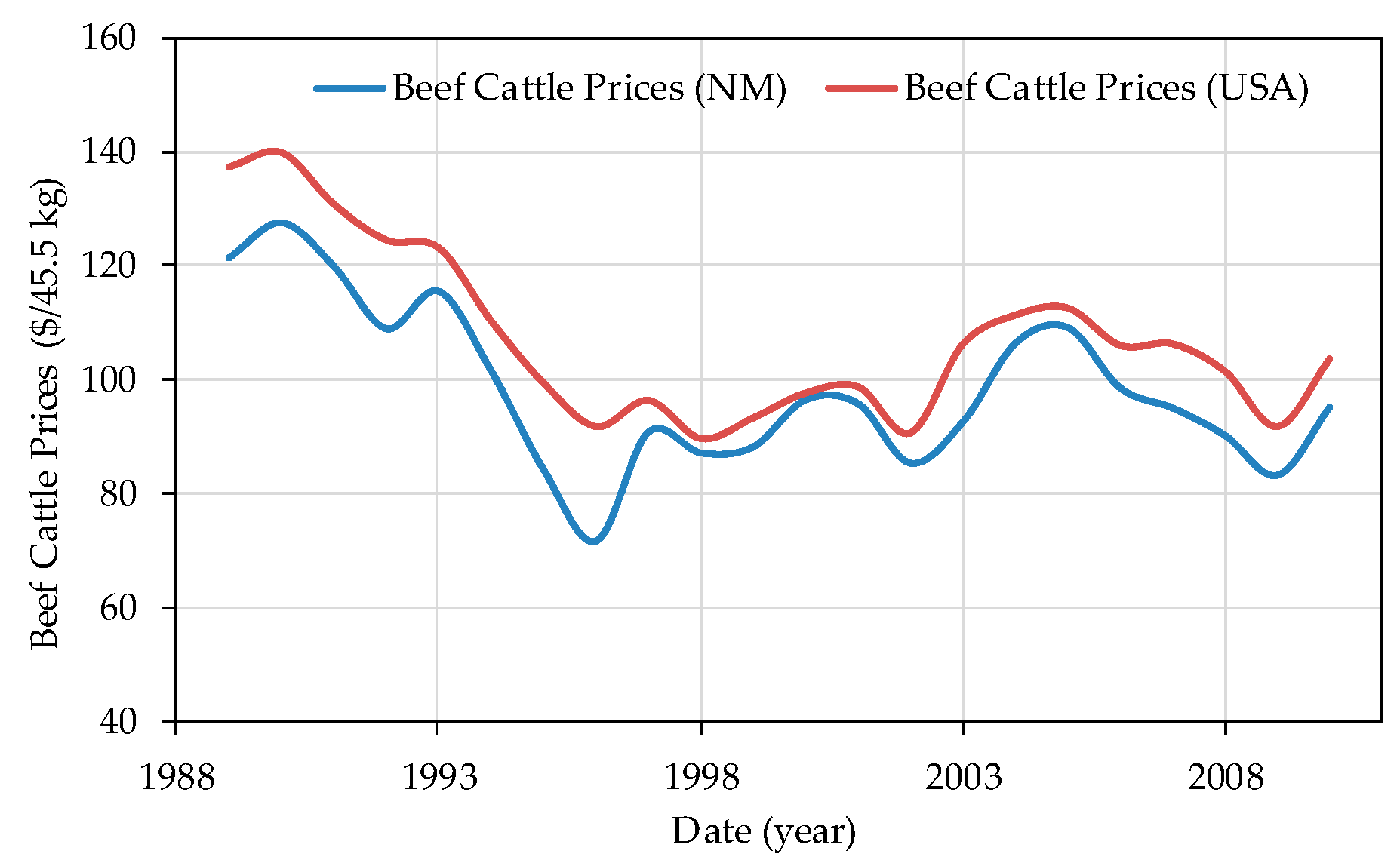
References
- World Resources Institute (WRI). World Resource Report: Creating a Sustainable Food Future: A Menu to Feed Nearly 10 Billion People by 2050; World Resources Institute: Washington, DC, USA, 2018; p. 96. [Google Scholar]
- Searchinger, T.; Waite, R.; Hanson, C.; Ranganathan, J.; Dumas, P.; Matthews, E.; Klirs, C. Creating a Sustainable Food Future. A Menu of Solutions to Feed Nearly 10 Billion People by 2050—Final Report; Library of Congress Control Number: 2019907466; Water Resources Institute: Washington, DC, USA, 2019; ISBN 978-1-56973-963-1. [Google Scholar]
- Trostle, R. Global Agricultural Supply and Demand: Factors Contributing to the Recent Increase in Food Commodity Prices; DIANE Publishing: Collingdale, PA, USA, 2010. [Google Scholar]
- Revell, B.J. One man’s meat… 2050? ruminations on future meat demand in the context of global warming. J. Agric. Econ. 2015, 66, 573–614. [Google Scholar] [CrossRef]
- Reidmiller, D.R.; Avery, C.W.; Easterling, D.R.; Kunkel, K.E.; Lewis, K.L.M.; Maycock, T.K.; Stewart, B.C.; Wuebbles, D.J.; Fahey, D.W.; Hibbard, K.A. (Eds.) USGCRP Impacts, Risks, and Adaptation in the United States: Fourth National Climate Assessment; Volume II: Report-in-Brief; U.S. Global Change Research Program: Washington, DC, USA, 2018; p. 186.
- Gowda, P.H.; Steiner, J.; Olson, C.; Boggess, M.; Farrigan, T.; Grusak, M.A. Chapter 10: Agriculture and Rural Communities. Impacts, Risks, and Adaptation in the United States: The Fourth National Climate Assessment; U.S. Global Change Research Program: Washington, DC, USA, 2018; Volume II.
- National Academies of Sciences, Engineering, and Medicine. Science Breakthroughs to Advance Food and Agricultural Research by 2030; National Academies Press: Washington, DC, USA, 2019; ISBN 0-309-47395-0. [Google Scholar]
- Godde, C.; Dizyee, K.; Ash, A.; Thornton, P.; Sloat, L.; Roura, E.; Henderson, B.; Herrero, M. Climate change and variability impacts on grazing herds: Insights from a system dynamics approach for semi-arid Australian rangelands. Glob. Chang. Biol. 2019, 25, 3091–3109. [Google Scholar] [CrossRef] [PubMed]
- World Meteorological Organization. The Global Climate in 2011–2015; WMO – No 1179; Chairperson, Publications Board World Meteorological Organization (WMO): Geneva, Switzerland, 2016; p. 32. ISBN 978-92-63-11179-1. [Google Scholar]
- Zhang, C.; Chen, X.; Li, Y.; Ding, W.; Fu, G. Water-energy-food nexus: Concepts, questions and methodologies. J. Clean. Prod. 2018, 195, 625–639. [Google Scholar] [CrossRef]
- Amundson, J.L.; Mader, T.L.; Rasby, R.J.; Hu, Q.S. Environmental effects on pregnancy rate in beef cattle. J. Anim. Sci. 2006, 84, 3415–3420. [Google Scholar] [CrossRef] [PubMed]
- Holechek, J.L. Drought in New Mexico: Prospects and management. Rangelands 1996, 18, 225–227. [Google Scholar]
- Boykin, C.C.; Gray, J.R.; Caton, D.D. Ranch production adjustments to drought in eastern New Mexico. 1962. Available online: http://contentdm.nmsu.edu/cdm/ref/collection/AgCircs/id/69939 (accessed on 1 December 2019).
- Holechek, J.L.; Pieper, R.D.; Herbel, C.H. Range Management. Principles and Practices, 6th ed.; Prentice-Hall: Upper Saddle River, NJ, USA, 1989. [Google Scholar]
- Kemper, N.; Flanders, A.; Watkins, B.; Popp, M. Impact of the 2012 Drought on Field Crops and Cattle Production in Arkansas Preliminary Report. Drought Impact 2013, 1–10. [Google Scholar]
- Holechek, J.L.; Sawalhah, M.N. Energy and Rangelands: A Perspective. Rangelands 2014, 36, 36–43. [Google Scholar] [CrossRef]
- Widmar, D.A. Global Beef Trends: China, Brazil Grab Spotlight. Available online: https://www.feedstuffs.com/news/global-beef-trends-china-brazil-grab-spotlight (accessed on 24 November 2019).
- Oscar, R. Food Trends: Meat Consumption Up, Beef Declines. Available online: https://www.globalmeatnews.com/Article/2016/04/13/Food-trends-meat-consumption-up-beef-declines (accessed on 24 November 2019).
- Culbert, J.I. Cattle Industry of New Mexico. Econ. Geogr. 1941, 17, 155–168. [Google Scholar] [CrossRef]
- Diemer, J.; Crawford, T.; Patrick, M. Agriculture’s Contribution to New Mexico’s Economy. Available online: https://aces.nmsu.edu/pubs/_circulars/CR675/welcome.html (accessed on 15 July 2019).
- New Mexico Office of the State Engineer/Interstate Stream Commission. New Mexico Water Use by Categories 2010. Available online: http://www.ose.state.nm.us/ (accessed on 28 March 2019).
- Hawkes, J.; Libbin, J. Cost and Return Estimates (CARE) for Farms and Ranches 2013–2019. Available online: https://costsandreturns.nmsu.edu./ (accessed on 18 July 2019).
- Rasul, G.; Sharma, B. The nexus approach to water–energy–food security: An option for adaptation to climate change. Clim. Policy 2016, 16, 682–702. [Google Scholar] [CrossRef]
- Sawalhah, M.N.; Holechek, J.L.; Cibils, A.F.; Geli, H.M.E.; Zaied, A. Rangeland Livestock Production in Relation to Climate and Vegetation Trends in New Mexico. Rangel. Ecol. Manag. 2019, 72, 832–845. [Google Scholar] [CrossRef]
- Nardone, A.; Ronchi, B.; Lacetera, N.; Ranieri, M.S.; Bernabucci, U. Effects of climate changes on animal production and sustainability of livestock systems. Livest. Sci. 2010, 130, 57–69. [Google Scholar] [CrossRef]
- Solomon, S.; Qin, D.; Manning, M.; Averyt, K.; Marquis, M.; Tignor, M.M. Climate Change 2007—The Physical Science Basis: Working Group I Contribution to the Fourth Assessment Report of the IPCC; Cambridge University Press: Cambridge, UK, 2007; Volume 4, ISBN 0-521-70596-7. [Google Scholar]
- Stoddart, L.A.; Smith, A.D.; Thadis, W.B. Range Management, 3th ed.; McGraw-Hill: New York, NY, USA, 1955. [Google Scholar]
- Hahn, G.L. Dynamic responses of cattle to thermal heat loads. J. Anim. Sci. 1999, 77, 10–20. [Google Scholar] [CrossRef] [PubMed]
- Mitlöhner, F.M.; Morrow, J.L.; Dailey, J.W.; Wilson, S.C.; Galyean, M.L.; Miller, M.F.; McGlone, J.J. Shade and water misting effects on behavior, physiology, performance, and carcass traits of heat-stressed feedlot cattle. J. Anim. Sci. 2001, 79, 2327–2335. [Google Scholar] [CrossRef] [PubMed]
- New Mexico First. Resilience in New Mexico Agriculture. Opportunities, Challenges and Realities for New Mexico’s Farming and Ranching Future. Available online: http://nmfirst.org/ (accessed on 28 March 2019).
- New Mexico First. 2018 State Water Planning Town Hall Background Report. Available online: http://nmfirst.org/ (accessed on 28 March 2019).
- Pieper, R.D.; Parker, E.E.; Donart, G.B.; Wright, J.D. Cattle and vegetational response to four-pasture and continuous grazing systems. N. M. Agric. Exp. Stn. Bull. 1991, 576. [Google Scholar]
- Holechek, J.; Galt, D.; Joseph, J.; Navarro, J.; Kumalo, G.; Molinar, F.; Thomas, M. Moderate and light cattle grazing effects on Chihuahuan Desert rangelands. J. Range Manag. 2003, 1, 133–139. [Google Scholar] [CrossRef]
- Holechek, J.L.; Gomez, H.; Molinar, F.; Galt, D. Grazing studies: What we’ve learned. Rangel. Arch. 1999, 21, 12–16. [Google Scholar]
- Gedefaw, M.G.; Geli, H.M.; Finegold, Y. Evaluating the impact of land use/land cover change on food production using cloud-based dense time series analysis to Support New Mexico’s Food-Energy-Water Systems Analysis. In Proceedings of the AGU Fall Meeting Abstracts, Washington, DC, USA, 10–14 December 2018. [Google Scholar]
- Allred, B.W.; Smith, W.K.; Twidwell, D.; Haggerty, J.H.; Running, S.W.; Naugle, D.E.; Fuhlendorf, S.D. Ecosystem services lost to oil and gas in North America. Science 2015, 348, 401–402. [Google Scholar] [CrossRef]
- Vengosh, A.; Jackson, R.B.; Warner, N.; Darrah, T.H.; Kondash, A. A critical review of the risks to water resources from unconventional shale gas development and hydraulic fracturing in the United States. Environ. Sci. Technol. 2014, 48, 8334–8348. [Google Scholar] [CrossRef]
- USA Department of Energy. Ensuring the Resiliency of Our Future Water and Energy Systems. Available online: https://www.energy.gov/energygov (accessed on 28 March 2019).
- Holechek, J.L.; Valdez, R. Natural Resources: Ecology, Economics, and Policy; Prentice Hall: Upper Saddle River, NJ, USA, 1999. [Google Scholar]
- Holechek, J.L. Changing western landscapes, debt, and oil: A perspective. Rangelands 2006, 28, 28–33. [Google Scholar] [CrossRef]
- Pelletier, N.; Pirog, R.; Rasmussen, R. Comparative life cycle environmental impacts of three beef production strategies in the Upper Midwestern United States. Agric. Syst. 2010, 103, 380–389. [Google Scholar] [CrossRef]
- Federal Reserve Economic Data | FRED | St. Louis Fed. Available online: https://fred.stlouisfed.org/ (accessed on 28 March 2019).
- USDA—National Agricultural Statistics Service—New Mexico. Quick Stats (Searchable Database) and Annual Statistical Bulletin. Available online: https://www.nass.usda.gov/Statistics_by_State/New_Mexico/index.php (accessed on 28 March 2019).
- Fan, X.; Fei, C.; McCarl, B. Adaptation: An Agricultural Challenge. Climate 2017, 5, 56. [Google Scholar] [CrossRef]
- Western Regional Climate Center. Available online: https://wrcc.dri.edu (accessed on 28 March 2019).
- GO-TECH: Home Page. Available online: http://octane.nmt.edu/gotech/ (accessed on 28 March 2019).
- López, S.; Cibils, A.; Smedly, U.; Guldan, S.; Fernald, A.; Ochoa, C.; Boykin, K.; Cibils, L. Linkages Between acequia Farming and Rangeland Grazing in Traditional Agropastoral Communities of the Southwestern USA. Sustainability 2018, 10, 2021. [Google Scholar] [CrossRef]
- McIntosh, M.M.; Holechek, J.L.; Spiegal, S.A.; Cibils, A.F.; Estell, R.E. Long-Term Declining Trends in Chihuahuan Desert Forage Production in Relation to Precipitation and Ambient Temperature. Rangel. Ecol. Manag. 2019, 72, 976–987. [Google Scholar] [CrossRef]
- Davis, D.; Schalles, R.R.; Kiracofe, G.H.; Good, D.L. Influence of winter nutrition on beef cow reproduction. J. Anim. Sci. 1977, 45, 430–437. [Google Scholar] [CrossRef]
- Hight, G.K. The effects of undernutrition in late pregnancy on beef cattle production. N. Z. J. Agric. Res. 1966, 9, 479–490. [Google Scholar] [CrossRef]
- Hitaj, C.; Suttles, S. Trends in U.S. Agriculture’s Consumption and Production of Energy: Renewable Power, Shale Energy, and Cellulosic Biomass. In Economic Information Bulletin; 2016. Available online: https://www.ers.usda.gov/webdocs/publications/74658/60128_eib159.pdf?v=0 (accessed on 1 December 2019).
- Prevatt, J.W.; VanSickle, J.J. United States Cattle Cycles: Perspectives on US Cattle and Calves Inventories and Prices; Food and Resource Economics Department, Florida Cooperative Extension Service, Institute of Food and Agricultural Sciences, University of Florida—Series FE 64; University of Florida: Gainesville, FL, USA, 2000; p. 10. [Google Scholar]
- Spiegal, S.; Estell, R.E.; Cibils, A.F.; James, D.K.; Peinetti, H.R.; Browning, D.M.; Romig, K.B.; Gonzalez, A.L.; Lyons, A.J.; Bestelmeyer, B.T. Seasonal Divergence of Landscape Use by Heritage and Conventional Cattle on Desert Rangeland. Rangel. Ecol. Manag. 2019, 72, 590–601. [Google Scholar] [CrossRef]
- Anderson, D.M.; Estell, R.E.; Gonzalez, A.L.; Cibils, A.F.; Torell, L.A. Criollo cattle: Heritage Genetics for Arid Landscapes. Rangelands 2015, 37, 62–67. [Google Scholar] [CrossRef]
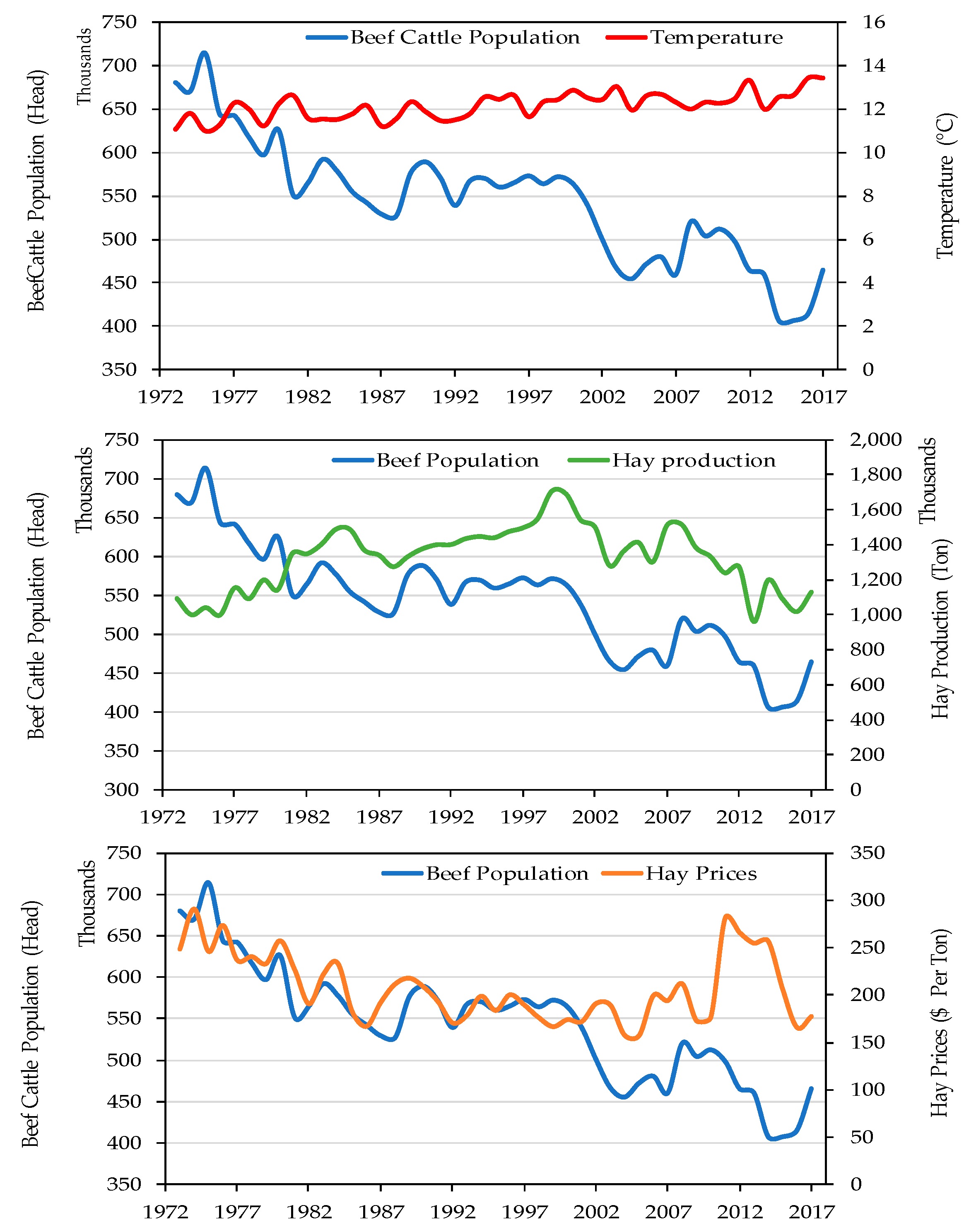
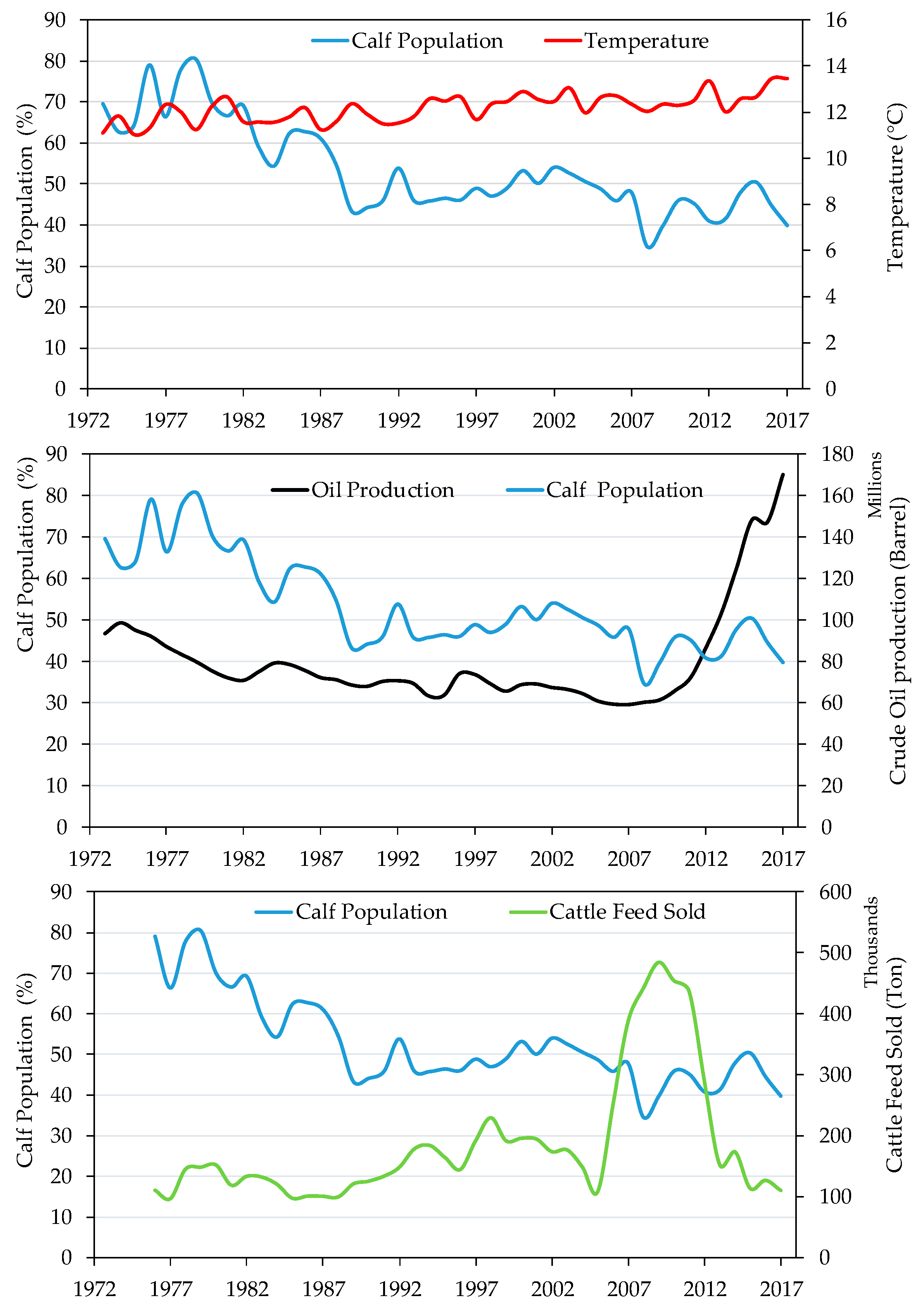
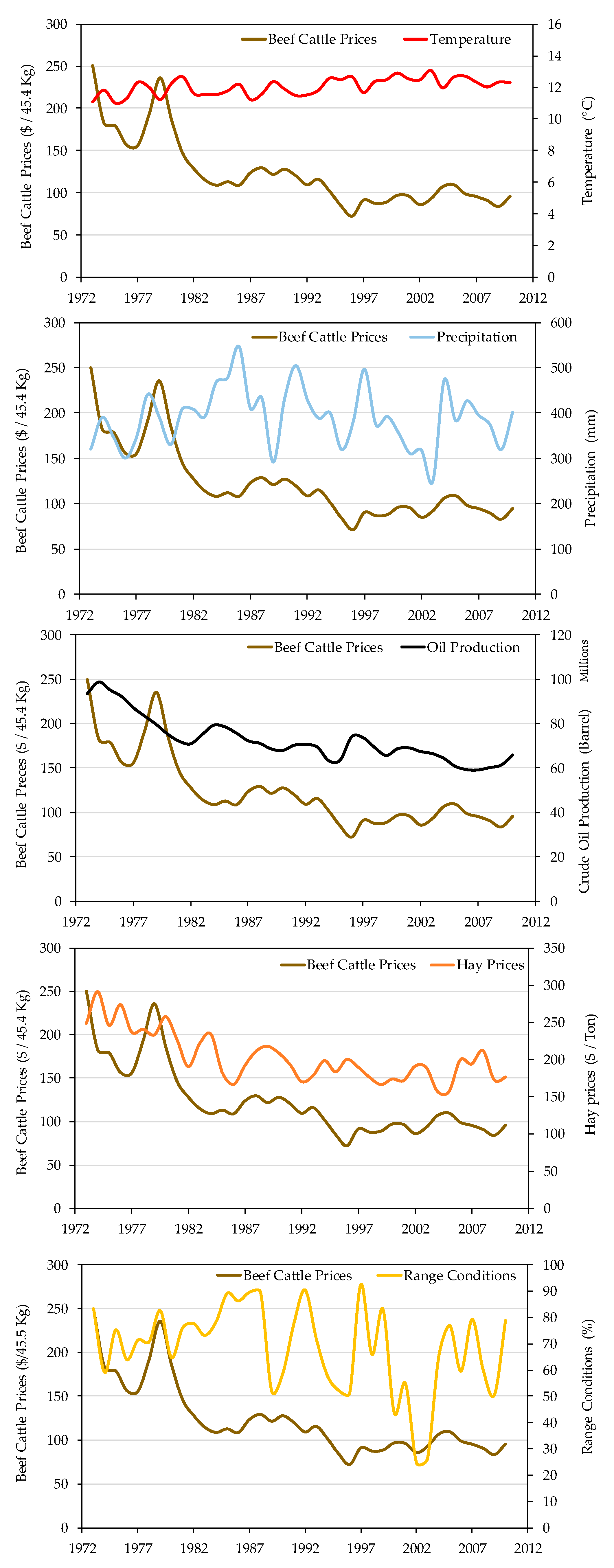
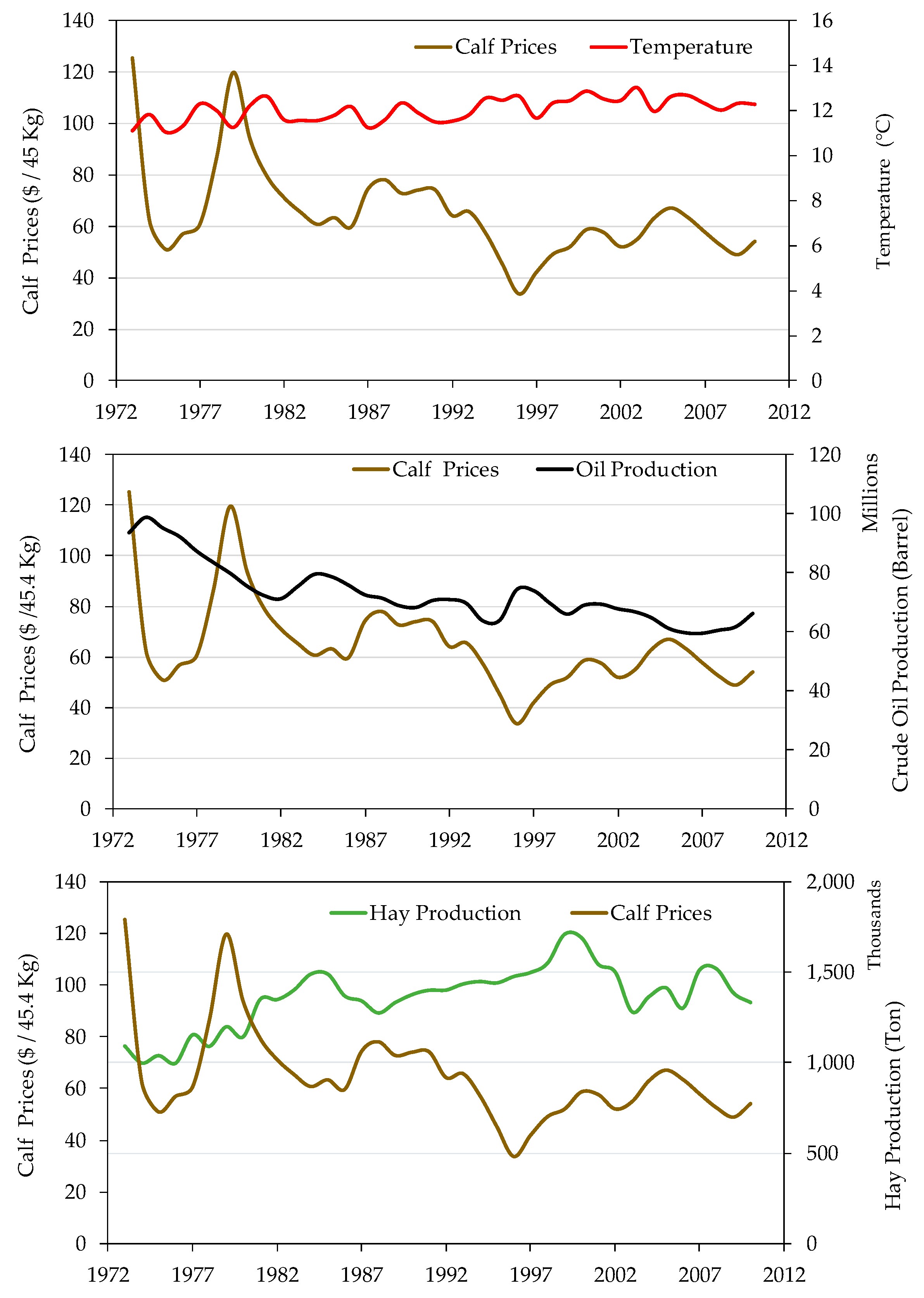
| Independent Variables | Model | Intercept | Estimate (β) | R2 |
|---|---|---|---|---|
| Mean Annual Temperature (°C) * | EGARCH | 840,045 | −24210 | 0.77 |
| Mean Annual Precipitation (mm) | EGARCH | 560,361 | 57.1596 | |
| Crude Oil Production (barrels) | EGARCH | 689,675 | −0.000038 | |
| Mean Annual Crude Oil Prices ($ per barrel) | EGARCH | 676,828 | 310.1408 | |
| Hay Production (tons) * | EGARCH | 559,446 | 0.1103 | 0.80 |
| Mean Annual Hay Prices ($ per ton) * | GARCH | 519,494 | 434.4435 | 0.80 |
| Mean Annual Range Conditions (%) | EGARCH | 552,698 | −10331 | |
| Cattle Feed Sold (tons) | EGARCH | 527,442 | 0.1453 |
| Independent Variables | Model | Intercept | Estimate (β) | R2 |
|---|---|---|---|---|
| Mean Annual Temperature (°C) * | EGARCH | 123.4081 | −5.8963 | 0.70 |
| Mean Annual Precipitation (mm) | EGARCH | 61.5349 | 0.007567 | |
| Crude Oil Production (barrels) * | EGARCH | 65.2082 | −1.475 × 10−8 | 0.70 |
| Mean Annual Crude Oil Prices ($ per barrel) | EGARCH | 66.3727 | −0.0935 | |
| Hay Production (tons) | EGARCH | 65.6726 | −1.612 × 10−6 | |
| Mean Annual Hay Prices ($ per ton) | EGARCH | 77.3626 | −0.0540 | |
| Mean Annual Range Conditions (%) | EGARCH | 57.3890 | 6.7819 | |
| Cattle Feed Sold (tons) * | EGARCH | 75.9448 | −1.824 × 10−6 | 0.72 |
| Independent Variables | Model | Intercept | Estimate (β) | R2 |
|---|---|---|---|---|
| Mean Annual Temperature (°C) * | EGARCH | 384.4344 | −13.8008 | 0.79 |
| Mean Annual Precipitation (mm) * | EGARCH | 201.2890 | 0.0592 | 0.74 |
| Crude Oil Production (barrels) * | GARCH | −20.1017 | 1.7844 × 10−6 | 0.62 |
| Mean Annual Crude Oil Prices ($ per barrel) | EGARCH | 220.3574 | 0.1547 | |
| Hay Production (tons) | EGARCH | 213.5465 | 7.8635 × 10−7 | |
| Mean Annual Hay Prices ($ per ton) * | EGARCH | −65.9333 | 0.9347 | 0.53 |
| Mean Annual Range Conditions (%) * | EGARCH | 206.1766 | 28.2504 | 0.78 |
| Cattle Feed Sold (tons) | GARCH | 159.7860 | −0.000033 |
| Independent Variables | Model | Intercept | Estimate (β) | R2 |
|---|---|---|---|---|
| Mean Annual Temperature (°C) * | EGARCH | 174.1819 | −6.1484 | 0.40 |
| Mean Annual Precipitation (mm) | EGARCH | 99.3902 | 0.007385 | |
| Crude Oil Production (barrels) * | EGARCH | 8.3233 | 7.8005 × 10−7 | 0.31 |
| Mean Annual Crude Oil Prices ($ per barrel) | EGARCH | 61.5146 | −0.0705 | |
| Hay Production (tons) * | EGARCH | 116.9502 | −0.000039 | 0.33 |
| Mean Annual Hay Prices ($ per tons) | EGARCH | 83.5743 | 0.0804 | |
| Mean Annual Range Conditions (%) | EGARCH | 89.5911 | 12.2472 | |
| Cattle Feed Sold (tons) | GARCH | 70.2113 | −0.000033 |
| Predictor | Beef Cattle Population (Head) | Calf Population (%) | Beef Cattle Prices ($/45.4 kg) | Calf Prices ($/45.4 kg) |
|---|---|---|---|---|
| Mean Annual Temperature (°C) | (−) 0.77 * | (−) 0.70 * | (−) 0.79 * | (−) 0.40 * |
| Mean Annual Precipitation (mm) | (+) 0.74 * | |||
| Crude Oil Production (barrel) | (−) 0.70 * | (+) 0.62 * | (+) 0.31 * | |
| Mean Annual Crude Oil Prices ($/barrel) | ||||
| Hay Production (ton) | (+) 0.80 * | (−) 0.03 * | ||
| Mean Annual Hay Prices ($/ton) | (+) 0.80 * | |||
| Mean Annual Range Conditions (%) | (+) 0.53 * | |||
| Cattle Feed Sold (ton) | (−) 0.72 * | (+) 0.78 * |
© 2019 by the authors. Licensee MDPI, Basel, Switzerland. This article is an open access article distributed under the terms and conditions of the Creative Commons Attribution (CC BY) license (http://creativecommons.org/licenses/by/4.0/).
Share and Cite
Zaied, A.J.; Geli, H.M.E.; Holechek, J.L.; Cibils, A.F.; Sawalhah, M.N.; Gard, C.C. An Evaluation of Historical Trends in New Mexico Beef Cattle Production in Relation to Climate and Energy. Sustainability 2019, 11, 6840. https://doi.org/10.3390/su11236840
Zaied AJ, Geli HME, Holechek JL, Cibils AF, Sawalhah MN, Gard CC. An Evaluation of Historical Trends in New Mexico Beef Cattle Production in Relation to Climate and Energy. Sustainability. 2019; 11(23):6840. https://doi.org/10.3390/su11236840
Chicago/Turabian StyleZaied, Ashraf J., Hatim M.E. Geli, Jerry L. Holechek, Andres F. Cibils, Mohammed N. Sawalhah, and Charlotte C. Gard. 2019. "An Evaluation of Historical Trends in New Mexico Beef Cattle Production in Relation to Climate and Energy" Sustainability 11, no. 23: 6840. https://doi.org/10.3390/su11236840
APA StyleZaied, A. J., Geli, H. M. E., Holechek, J. L., Cibils, A. F., Sawalhah, M. N., & Gard, C. C. (2019). An Evaluation of Historical Trends in New Mexico Beef Cattle Production in Relation to Climate and Energy. Sustainability, 11(23), 6840. https://doi.org/10.3390/su11236840





